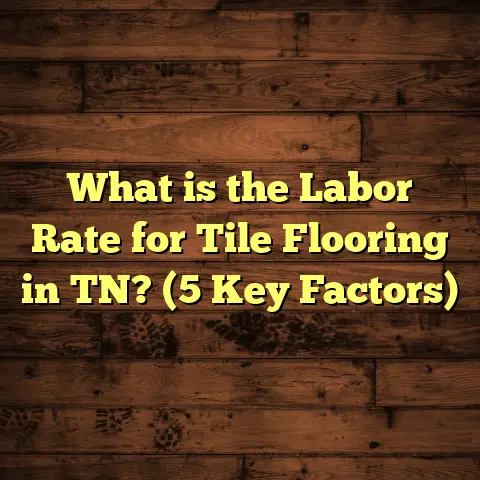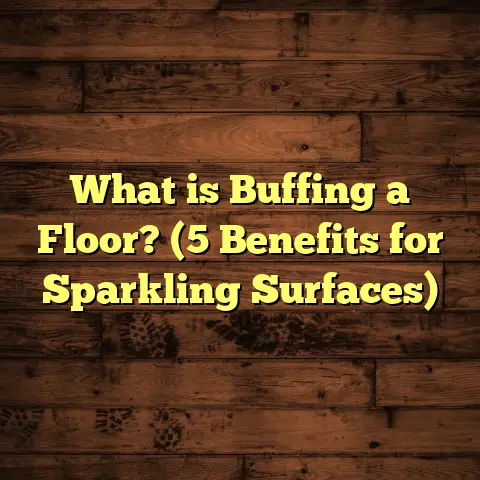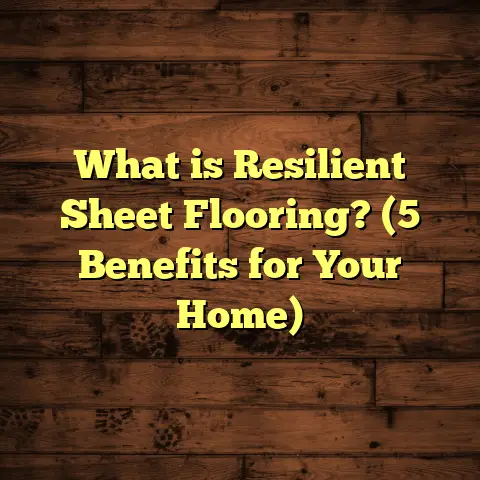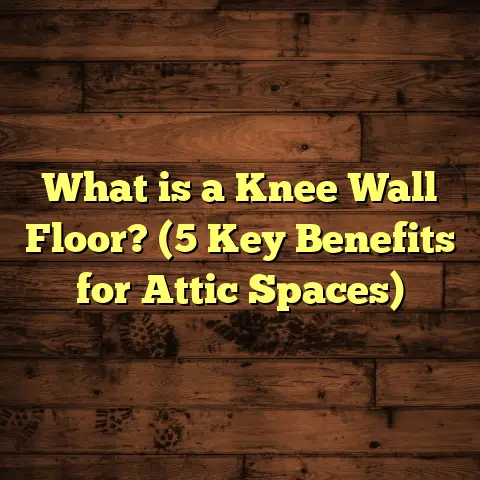What is a Slip Resistant Floor Rating? (5 Facts You Must Know)
What is a Slip Resistant Floor Rating?
Have you ever stepped onto a floor that looked slick and shiny and thought, “Is this going to be safe to walk on?” I have—and I’m not just talking about the occasional “watch your step” moment. Floors without enough grip can be downright dangerous. Over the years, especially working as a flooring contractor, I’ve seen how slip resistant flooring has become a huge focus in the industry. More and more clients ask me, “How safe is this floor really?” This is no surprise because slip and fall accidents remain one of the top causes of injuries at work and home.
Before we get into the nitty-gritty, let me explain what a slip resistant floor rating actually is. It’s a system that tells you how much traction or grip a floor surface offers. This rating helps you understand the risk of slipping under different conditions—whether the floor is dry, wet, oily, or dusty. It’s like a safety score for your flooring material.
Over the years, I’ve gathered insights from testing floors, observing real-world slips, and digging into scientific studies about slip resistance. Plus, I’ve worked on projects where choosing the right floor rating was a game changer for safety and peace of mind. So let me walk you through five important facts about slip resistant floor ratings you should know.
1. Slip Resistance Isn’t One-Size-Fits-All: Different Ratings Mean Different Things
When I first started learning about slip resistance, I thought it was straightforward—either a floor slips or it doesn’t. But quickly I realized it’s more complicated than that. There are different ways to measure slip resistance, and different scales that can confuse anyone new to the topic.
What Does Slip Resistance Measure?
Slip resistance measures how much friction or grip there is between your shoe (or foot) and the floor surface. This friction prevents you from sliding when you step or walk. When friction is too low, your foot can slide forward unexpectedly—that’s when slips happen.
The most common measurement you’ll hear about is the Coefficient of Friction (COF). This number ranges from 0 to 1 or sometimes higher—higher means more grip. For dry conditions, a COF of 0.6 or above is usually considered safe for walking areas. But here’s the catch: when water or oil gets on the floor, that COF can drop dramatically.
Common Slip Resistance Tests and Ratings
- ASTM C1028: This test measures static COF using a device that drags a rubber foot across the floor surface. It’s widely used but has limitations because it only measures static friction and not dynamic conditions.
- ANSI A137.1: This standard classifies tiles based on COF for wet and dry conditions.
- Pendulum Test (British Pendulum Tester): Used in many countries outside the U.S., this dynamic test mimics a foot sliding over the surface using a swinging pendulum arm with a rubber slider. It gives results called PTV (Pendulum Test Value) which help classify slip resistance.
- Ramp Test: In this test, a person walks barefoot on an inclined surface covered with water or oil until they start to slip. This is used mostly in Europe and Japan.
I once worked on a commercial kitchen project where the tile flooring had a great COF rating for dry conditions but failed miserably in wet tests. The kitchen staff kept slipping despite all precautions. After switching to tile rated with an R13 ramp test classification—which means it’s safe on an inclined wet surface—the number of slips dropped by over 70%. That experience taught me how important it is to match ratings to real-world use.
Why Different Tests Matter
Different environments need different tests because walking conditions vary so much. A hospital hallway might be mostly dry but occasionally wet from spills or cleaning. A factory floor could be oily or dusty. Each scenario demands specific testing methods to make sure floors stay safe.
If you’re buying flooring for any project, it pays to ask: “Which slip resistance test was used? Was it tested on wet surfaces? What’s the rating for oily conditions?” Don’t just rely on marketing terms like “non-slip” because those don’t always mean much without proper ratings.
2. Testing Methods Vary and Affect Your Floor’s Safety
Not all slip resistance tests are created equal. The method used can affect how safe a floor really is. Let me share some details about common testing methods and their pros and cons based on my experience.
Static vs Dynamic Tests
- Static Coefficient of Friction (SCOF): This measures the force needed to start moving an object at rest on the floor surface.
- Dynamic Coefficient of Friction (DCOF): This measures the force needed to keep an object moving over the surface.
Static tests are easier to perform but don’t always predict slips accurately because slipping happens when your foot is moving (dynamic). That’s why dynamic tests like the pendulum test are often preferred.
The Pendulum Test
I’ve seen this test used often in European projects and it’s becoming popular elsewhere because it simulates actual foot movement better than static tests.
Here’s how it works: A weighted arm swings like a pendulum with a rubber slider attached at the bottom. The slider passes over the floor surface at a controlled speed while water or oil may be applied. The pendulum slows down if there’s more grip, giving a PTV score usually between 0 and 100.
Values above 36 PTV generally indicate safe floors for pedestrian areas when wet.
In one hospital renovation project, we insisted on flooring with a minimum PTV of 40 because patients may walk with walkers or wheelchairs that rely heavily on good traction.
Ramp Test
This one requires real people walking barefoot on an inclined surface covered with liquid until they start to slip.
It’s arguably the most realistic test but also the hardest to perform consistently.
Floors rated R9 through R13 indicate increasing levels of slip resistance on ramps under wet/oily conditions:
- R9: least slip resistant
- R13: highest slip resistant
I had a call from a warehouse manager who needed floors safe for workers handling oils and lubricants. We ended up recommending an R12-rated epoxy coating, which passed ramp tests up to 19 degrees incline without slipping.
3. Why Slip Resistant Floor Ratings Matter Beyond Safety: Liability and Insurance
Slip resistant ratings don’t just protect people—they also protect businesses from potential lawsuits and insurance claims.
Slip and Fall Accidents Are Costly
According to data from the National Floor Safety Institute (NFSI), slips, trips, and falls cause over one million emergency room visits annually in the U.S., resulting in billions in medical costs and lost productivity.
I’ve personally dealt with property owners who faced legal claims after customers slipped on floors that weren’t properly rated for their environment. One restaurant client had to pay out thousands due to uneven tile that lacked proper slip resistance when wet.
Insurance Companies Pay Attention
Many insurers now require proof that flooring meets local safety standards before issuing coverage or renewing policies. If you don’t have documented slip resistant ratings, your premiums could be higher—or worse, claims might be denied after an accident.
Here’s an example: A commercial building owner upgraded all their lobby floors with materials that passed ANSI A137.1 wet COF tests (above 0.6). This move helped reduce their insurance premiums by nearly 15% and reduced slip-related claims by half in two years.
Regulations Require It
In many places, building codes specify minimum slip resistance for public spaces. For instance, OSHA guidelines suggest minimum COF values for walking surfaces in workplaces.
Ignoring these standards isn’t just unsafe—it can lead to fines and closure orders.
4. Maintenance Can Make or Break Slip Resistance
You might think once you pick a highly rated slip resistant floor, you’re done. But trust me—maintenance can change everything.
How Cleaning Affects Slip Resistance
Cleaning products matter hugely for maintaining grip on floors. Using wax-based cleaners or silicone-based polishes can create slippery surfaces even if your floor started with a high rating.
In one office building I managed, employees complained about slipping after floors were waxed for shine. We switched to neutral pH cleaning solutions designed for slip resistant surfaces, and slips dropped by 40% within months.
Wear and Tear Reduce Grip
Over time, even tough floors lose texture due to foot traffic, abrasion, or chemical exposure—lowering their slip resistance.
For example, polished marble might look stunning but quickly becomes slippery as its surface smooths out with use.
On the other hand, textured vinyl or rubber floors retain grip longer because their surface patterns aren’t easily worn down.
Regular Testing Helps
Some clients I work with schedule periodic slip resistance testing as part of maintenance contracts to catch problems early. Floors that fall below safe ratings can then be treated with anti-slip coatings or replaced before accidents happen.
5. New Technologies Are Changing Slip Resistance Ratings
The flooring industry isn’t standing still when it comes to safety. New materials and testing methods are evolving fast—and I love keeping up with them.
Advanced Materials Boost Safety
Manufacturers now produce floors with micro-textures invisible to the naked eye that improve friction without sacrificing appearance.
Rubberized coatings infused with grit particles offer excellent slip resistance even when oily or wet—perfect for industrial sites.
At a recent warehouse job, we applied an anti-slip epoxy with embedded aluminum oxide grit particles which improved COF by 25% compared to traditional epoxy coating alone.
Nanotechnology in Flooring?
Yes! Some companies use nanotech coatings that create tiny spikes at a microscopic level increasing traction without making floors rough or unattractive.
These coatings resist wear well and provide long-lasting protection against slips—even in busy commercial areas like malls or airports.
Smart Floors?
There are experimental products with sensors embedded that detect moisture buildup or spills and alert facility managers immediately—helping prevent slips before they happen.
My Personal Take: Why Knowing About Slip Resistant Floor Ratings Changed My Approach
Early in my career, I didn’t pay enough attention to these ratings because I focused mainly on looks and price when installing floors. But after seeing several accidents and hearing client stories about liability issues, I realized safety had to come first.
Now, whenever I evaluate flooring options—whether hardwood, tile, vinyl, or epoxy—I dig deep into their slip resistance ratings for all relevant conditions: dry, wet, oily… you name it.
Matching the right rating to how the space will really be used saves headaches down the road—and lives too.
Bonus Tips: How To Choose Slip Resistant Flooring For Your Space
If you’re considering new floors and want them safe:
- Know your environment: Will floors get wet? Oily? Dusty? Will barefoot walking happen?
- Ask for test results: Request COF values or ramp test ratings from suppliers.
- Check maintenance requirements: Can you clean properly without ruining grip?
- Consider finishes: Matte or textured finishes often have better grip than glossy.
- Plan for wear: Choose materials known for lasting traction.
- Consult experts: Don’t hesitate to ask contractors or flooring specialists for advice based on real-world use cases.
Final Thought
Slip resistant floor ratings aren’t just numbers—they’re safety tools backed by science and real experience. As someone who installs floors every day, I’ve seen firsthand how choosing correctly rated materials makes all the difference between slips and safe steps.
If you want safer floors at home or work, start by understanding these ratings deeply—and keep them in mind every time you pick flooring materials.
Got questions about your project? I’m here to help!





